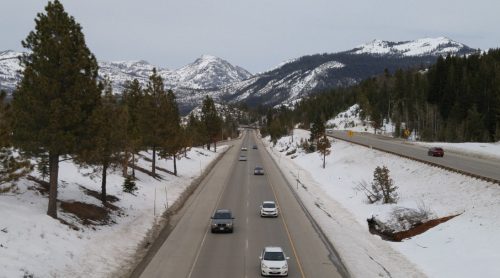The series of atmospheric rivers that hit California in the months of December and January certainly improved the state’s snowpack, state water officials confirmed during their second snow survey of the year.
Results from the state’s latest manual snow survey, conducted on Wednesday, recorded 85.5 inches of snow at the Sierra Nevada’s Phillips Station, which is 193 percent of average for the area at this time of year.
Electronic snow sensors installed around California reveal that statewide, the snowpack is 205 percent of average for Feb. 1, which beats the state’s record snow levels in 1982.
The numbers come after the state endured one of its wettest three-week periods ever, which followed a severe three-year drought and a prolonged heat wave over the summer.
David Rizzardo, hydrology manager for the California Department of Water Resources, said January’s atmospheric rivers ensures that this year’s data is different than that of last’s, when the state was hit with the driest January, February and March on record after reaching snow depths of 150 percent above normal at the beginning of 2022.
“There’s a contrast to the year before, when we did have some good storms in December and a really good snowpack around January 1, but those were only two or three atmospheric rivers,” Rizzardo said. “So it is a major difference when you have that number of storms all coming in at different angles and orientations into the mountains and really distributing snow fairly well.”
Rizzardo added that the snow in higher elevations is very cold and not very dense – the perfect conditions for the snowpack to last until Spring. Snow in lower parts of the mountains is likely to melt quickly and rebuild, which is not alarming, he said.
State water officials air on the side of caution before celebrating, as California still has two months before it should reach its snowpack peak for the wet season. Called the “frozen reservoir,” the snowpack makes up about 30 percent of the state’s water supplies and significantly influences how water officials manage the state’s water supplies.
“California has always experienced some degree of swings between wet and dry, but the past few months have demonstrated how much more extreme those swings are becoming,” said DWR Director Karla Nemeth. “California is preparing for more intense and dangerous climate swings by bolstering both drought and flood preparation.”
California typically receives about half of its annual precipitation during December, January and February, said State Climatologist Michael Anderson. This season, the state received 80 percent of its snowfall in a matter of three weeks.
But Jeanine Jones, interstate resources manager at DWR, added that above-average rain and snow levels does not necessarily translate into water for Californians’ taps. She said that the state’s groundwater and reservoir systems are like “really big buckets” that need more than just one good wet season to be fully replenished, after years of depleted levels.
“Some areas will likely come out of drought conditions because of the very wet conditions that we’ve had, but it really depends on the circumstances of a water suppliers,” said Jones. “If they’re taking water from just only groundwater in an area that’s been very depleted over time, or if they’re taking water from a reservoir that’s really full.”



An irrelevant statistic in terms of the drought trend.
.
What is the rain water equivalent?
.
Might be able to find it here.
https://tinyurl.com/2p98feux
Basically means they need to start releasing the water from the reservoirs to make room for the melting snow. State leadership needs to do more to capture water, maybe get the money in the name of climate change.
No sweat it will be out in the ocean in no time.
But Newscum still wants us to believe we are in a drought. To help his point, he would rather release the water to the ocean, than permit us to use it.
Thanks newscum!
Daily Reservoir Storage Summary
https://cdec.water.ca.gov/reportapp/javareports?name=RES
.
If you’d like to calculate gallons per minute flowing in (inflow)
https://calculator.academy/cfs-to-gpm-calculator/
.
Oroville inflow is 6,643 cfs . . . . is 2,981,776 gpm
https://oroville.lakesonline.com/Level/
All these state officials are all so negative how about something good to say and boost morale.We might not be out of a drought but make adjustment’s to store more water you dumd ass officials.
Will CCWD lower our water rates?.